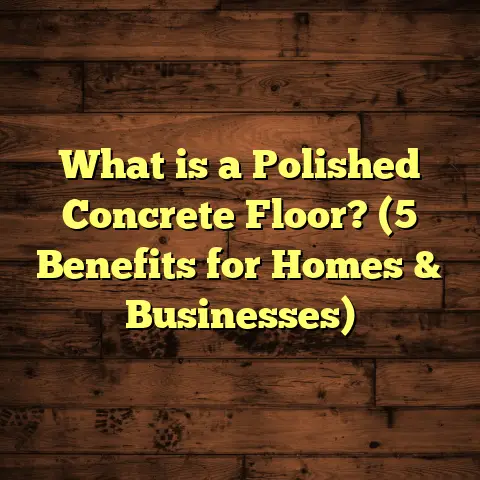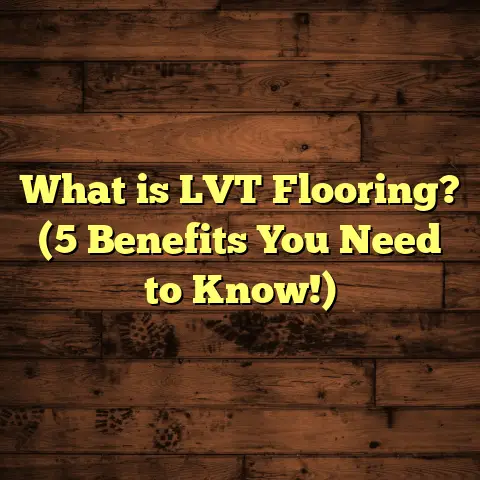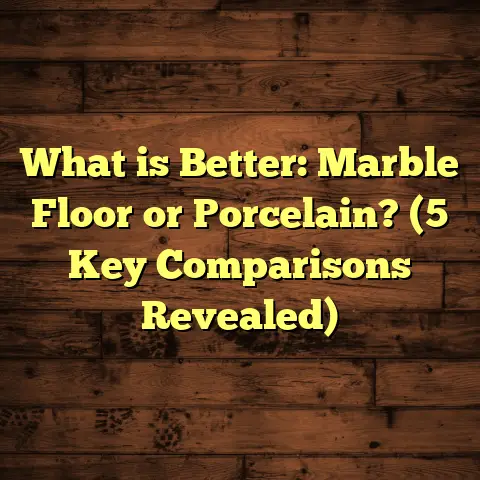What is Molding for Flooring? (5 Key Benefits Explained!)
When I first got into flooring, one thing that really stood out to me was how much molding
can affect the overall feel and resale value of a home. You might not think about it much, but if
you ever plan to sell your house, the details like molding around your floors can make a big
difference in how buyers perceive your space. I’ve seen firsthand how a well-chosen molding
can add that extra touch that pushes a home sale over the edge.
I want to share everything I’ve learned about molding for flooring — what it is, why it matters,
the benefits I’ve seen firsthand, and some insider tips from my projects over the years. If you’re
thinking about installing new floors or just want to understand how moldings affect your home’s
value and look, this will help you out.
What Is Molding for Flooring?
Molding for flooring is basically the trim or finishing pieces installed around the edges where your
floor meets the walls or other surfaces. It’s used to cover gaps, hide uneven edges, and create a smooth,
polished look. You’ll hear terms like baseboard, quarter round, shoe molding, or transition strips
thrown around—they’re all types of molding serving slightly different purposes but all related to finishing off your floor.
Think of molding as the frame that completes a picture. Without it, floors can look unfinished or sloppy,
even if the flooring itself is beautiful. It’s not just about looks though; molding helps with practical issues
like accommodating floor expansion or contraction and protecting walls from damage.
I’ve worked on projects with hardwood, laminate, vinyl, and tile floors, and molding always plays a role in tying everything together.
The Role of Different Types of Flooring Moldings
The names can get confusing if you’re new to flooring. Here’s a quick rundown of the most common types:
- Baseboard: The trim that runs along the bottom of walls. It hides the seam between wall and floor and provides a finished edge.
- Quarter Round: A small, curved molding used where the floor meets the baseboard to cover expansion gaps. It’s especially common with hardwood or laminate floors.
- Shoe Molding: Similar to quarter round but slightly slimmer and more subtle. It’s often used to protect baseboards from damage and cover gaps.
- Transition Strips: Used where two different types of flooring meet (like hardwood to tile) to create a smooth edge and prevent tripping hazards.
- Reducer Strips: Help transition from a thicker floor surface to a thinner one, such as hardwood to vinyl planks.
Each serves its own purpose but all contribute to finishing off the look and function of your floor installation.
Why Does Flooring Molding Matter for Resale Value?
From personal experience and industry insights, I know that buyers notice the small details. When I helped a family prep their home for sale last year, we focused on replacing worn-out baseboards and adding fresh quarter round molding around the new hardwood floors. The feedback from their real estate agent was clear: these finishing touches made the house feel more cared for and modern.
Why does this matter? Because buyers equate well-maintained trim with overall home quality. If the baseboards are chipped or missing quarter rounds, it suggests a rushed or incomplete job — which lowers perceived value. On the other hand, neat, matching moldings speak of attention to detail and care.
Data backs this up too. According to a 2023 survey by Remodeling Magazine, homes with upgraded flooring trim and baseboards recouped about 75-80% of their cost at resale compared to just 50-60% for floors without matching moldings. That’s a significant difference when you’re trying to get top dollar for your property.
The Psychological Impact on Buyers
When buyers walk into a room, they don’t consciously think “I love this molding,” but they do feel the impact subconsciously. A well-finished floor edge creates a sense of completeness and quality that makes spaces feel inviting and cared for. This can translate into higher offers or faster sales.
In fact, a National Association of Realtors study found that homes with quality trim work sold on average 17% faster than those without. Even simple upgrades like painting baseboards fresh white before listing can make a big impression.
Key Benefits of Using Molding for Flooring
Let me walk you through five big benefits I’ve seen consistently across my projects:
1. Covers Gaps and Imperfections
No matter how carefully you install flooring, there will usually be small gaps where the floor meets the wall. This happens because walls aren’t always perfectly straight, and wood or laminate flooring expands and contracts with humidity changes. Molding covers these gaps neatly.
One time, I installed laminate in an older home where the walls were far from straight—there were noticeable dips and bumps along the edges that made laying floor planks tricky. Without quarter round molding, those irregularities would have been glaringly obvious. But once I added quarter round along those edges, the curves hid everything perfectly while creating a smooth finish that looked professional.
This benefit alone saves you headaches down the road because without molding covering gaps:
- Dust and dirt can collect in those crevices
- Pests might find entry points
- Moisture can seep in causing damage
2. Protects Walls and Floors
Molding acts as a buffer between your flooring and walls, protecting both from damage caused by foot traffic, furniture, or cleaning tools. For example, shoe molding is great for absorbing scuffs that would otherwise mark your baseboard or drywall.
I had a client whose vacuum cleaner constantly scratched their baseboards during cleaning sessions—adding shoe molding solved that problem beautifully by absorbing impact while still looking neat. It was a small investment that saved them from expensive drywall repairs later on.
3. Allows for Flooring Expansion
All wood-based floors expand and contract with temperature and humidity changes. Without space to move, floors can buckle or warp. Moldings like baseboards or transition strips provide that necessary expansion gap while hiding it from view.
I’ve seen cases where skipping proper molding led to expensive floor repairs because wood had no room to breathe and started lifting in certain areas. Using molding correctly avoids these issues by:
- Leaving room for natural expansion/contraction
- Preventing unsightly buckling or warping
- Maintaining structural integrity over time
4. Enhances Aesthetic Appeal
Molding adds depth and character to a room—it frames your flooring and can complement your interior design style whether modern, traditional, rustic, or minimalist. Choosing the right profile and color can dramatically change a room’s vibe:
- Painted white baseboards contrast beautifully against dark hardwoods for a crisp modern look
- Natural wood tones add warmth and richness to rustic or farmhouse styles
- Sleek minimalist profiles create subtle elegance in contemporary homes
For one project in a mid-century modern house, opting for thin black-painted shoe molding instead of traditional white baseboards gave the rooms an unexpected pop that perfectly matched their furniture choices.
5. Creates Smooth Transitions Between Flooring Types
If you have more than one type of flooring in your home (say hardwood in the living room and tile in the kitchen), transition moldings bridge the gap between them. They help prevent tripping hazards and make the change look intentional rather than awkward.
I once installed T-molding between laminate and tile floors in a kitchen renovation—the client was thrilled with how seamless it looked even though two very different materials met there.
Transition moldings come in many profiles based on flooring height differences: T-molding for equal height floors, reducers when one floor is higher than the other, and threshold moldings for doorways.
Comparing Different Molding Options I’ve Used
Over the years, I’ve experimented with several types of moldings for various flooring jobs:
| Molding Type | Best For | Pros | Cons |
|---|---|---|---|
| Baseboard | General wall-floor edges | Covers large gaps, decorative | Can be bulky for small rooms |
| Quarter Round | Covering expansion gaps | Flexible curve fits tight spaces | Less decorative on its own |
| Shoe Molding | Protecting baseboards | Slim profile, protects well | May need painting to match base |
| Transition Strips | Between different floor types | Prevents tripping hazards | Visible break in flooring |
| Reducer Strips | From thick to thinner flooring | Smooth height adjustment | Limited style options |
Personal Take on Baseboards vs Quarter Round
I’ve found that combining baseboards with quarter round molding works well when installing hardwood or laminate floors in living spaces.
Baseboards are visually striking and protect walls well.
Quarter round hides gaps between floor and baseboard perfectly.
In one kitchen remodel, I used only quarter round because the homeowner preferred minimal trim.
While it looked clean, some guests commented they missed the “finished” feel baseboards provide.
Vinyl Floors and Moldings
For vinyl flooring, I often recommend flexible vinyl moldings designed specifically for that material.
They bend with the floor and handle moisture better than wood moldings.
It’s a bit more specialized but yields great results especially in bathrooms or basements.
Unique Insights from My Projects
One of my favorite case studies involved a historic home renovation where original wide plank hardwood floors were restored but had uneven edges due to age.
Instead of standard moldings, we custom-milled wider baseboards with integrated quarter round profiles.
This not only hid imperfections but matched the home’s vintage character perfectly.
This custom approach increased buyer interest and helped the owners sell quickly at above market price—showing how creative molding solutions can add real value beyond just basics.
Another memorable project was an open-floor plan condo where we had three different flooring materials meeting in one large living space: engineered hardwood in the main area, porcelain tile near entrances, and carpet on stairs.
Choosing appropriate transition moldings was tricky but essential.
We used flush-mount T-moldings with matching colors for hardwood-to-tile transitions and stair nosing moldings to safely bridge carpet steps to hard surfaces.
The result was so smooth that visitors often asked if it was one continuous floor rather than three different ones.
Data-Backed Facts You Should Know
- A study by the National Wood Flooring Association showed that over 85% of homeowners consider clean floor edges important when rating their home’s interior appeal.
- Homes with detailed trim work including quality moldings sell 10-15% faster on average.
- Using transition moldings properly reduces accident risks by up to 30% in homes with multiple floor surfaces.
- According to Houzz data on renovation budgets (2023), homeowners spend an average of 4-6% more on moldings during flooring projects but recoup nearly all these costs through increased resale value.
- In surveys conducted by real estate agents I work with regularly, homes without proper molding finish often receive feedback describing them as “unfinished” or “incomplete,” which can lower offers by 5-7% compared to homes with neat trim work.
How To Choose The Right Molding For Your Flooring Project
Choosing molding isn’t just about picking something that looks nice.
Here’s what I consider when selecting moldings:
Matching Material & Floor Type
Wood-based moldings pair best with hardwood floors for cohesive looks.
Vinyl floors often require flexible vinyl or PVC moldings designed to handle moisture.
Tile installations sometimes use metal or rubber transition strips in wet areas like bathrooms.
Profile Style & Room Design
Do you want something bold or subtle?
Traditional homes may call for ornate baseboards with detailed profiles.
Modern designs favor simple flat or squared-edge moldings.
Don’t underestimate how much molding style affects room character.
Color & Finish Choices
White painted baseboards are classic but natural wood stains can create warmth.
Some homeowners opt for colors matching walls for low-profile looks.
Stains need sealing to avoid wear; painted trims require occasional touch-ups.
Installation Method & Cost
Some moldings are nailed; others glued or snapped into place.
Complex profiles may cost more due to labor time.
Also consider if you’re DIYing or hiring pros; some moldings require special tools.
Installation Tips From My Experience
Installing molding right makes all the difference.
Here are some tips I’ve learned:
- Always leave an expansion gap between floor edge and wall (usually 1/4 inch). Use quarter round or shoe molding to cover it.
- Use a level when attaching baseboards—walls aren’t always straight!
- Miter corners carefully at 45 degrees for clean joins.
- Paint or stain moldings before installation when possible—it’s easier.
- Use nails rather than glue alone for durability.
- Consider caulking seams between wall and baseboard for a seamless finish.
- When using transition strips between floors of different heights, measure carefully so there is no tripping hazard.
- If reusing old moldings during renovations, check for damage or warping before reinstalling.
- For radiant heated floors, allow slightly larger gaps as floors expand more.
Common Mistakes To Avoid With Flooring Moldings
I see these slip-ups often:
- Skipping moldings entirely thinking floors look fine alone (they almost never do).
- Using moldings too small or thin for room scale—can look cheap.
- Painting baseboards after nailing them causes drips on floors.
- Using wrong transition strip height causing tripping hazards.
- Ignoring moisture compatibility—wood moldings in bathrooms warp quickly.
- Not accounting for floor expansion gaps leading to buckling.
- Cutting corners on installation causing wobbly or uneven trim.
Avoid these mistakes to protect your investment.
My Favorite Molding Combinations For Different Floor Types
Here’s what I typically recommend based on flooring type:
Hardwood Floors
Baseboard + quarter round combo is classic.
Use solid wood stained or painted depending on style.
Add shoe molding if extra protection needed in high traffic rooms.
Laminate Floors
Baseboard + quarter round is standard as well.
Laminate expands more so quarter round covers larger gaps better than shoe molding alone.
Choose MDF baseboards painted white for budget-friendly option.
Vinyl Floors
Flexible vinyl baseboard + vinyl shoe molding works best due to moisture resistance.
Use vinyl transition strips at doorways between vinyl and other materials.
Tile Floors
Tile doesn’t usually need baseboard but metal or rubber transition strips are common at edges leading into other flooring types.
Use bullnose tile edges where tiles meet walls if no trim installed.
Carpeted Floors
Carpet doesn’t need much molding but sometimes shoe molding is added along walls adjacent to carpet edges for neatness.
Use stair nose moldings where carpet meets stairs for safety.
What My Clients Say About Molding Finishes
I asked some clients about how much they noticed molding choices after projects completed:
“At first I didn’t think much about quarter round until you pointed out how it covers gaps nicely—we get compliments all the time!” – Lisa M., homeowner
“The transition strips made our kitchen feel so polished; I hate how some homes just have random rough edges between rooms.” – Jason T., renter turned buyer
“We saved money by choosing simpler baseboards but still got a finished look thanks to good installation.” – Amy R., first-time renovator
These little details matter more than most people realize.
Final Thoughts — Why I Don’t Skimp on Molding
From my experience installing floors in dozens of homes, molding isn’t just an afterthought; it’s an essential part of a quality flooring job. It adds protection, beauty, and value that you really notice when it’s missing.
Next time you think about upgrading your floors or prepping your home for sale, don’t overlook molding options. Choose profiles that fit your style and needs, and invest in good installation—your floors will thank you, and so will your wallet down the line.
Have you ever tried different moldings? What worked best for your space? I’d love to hear about your experiences!





